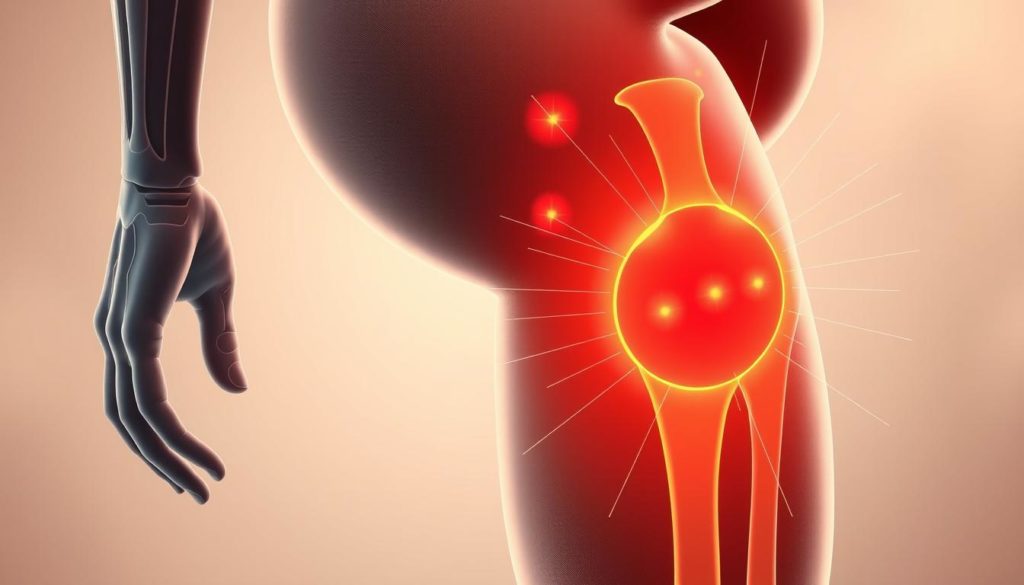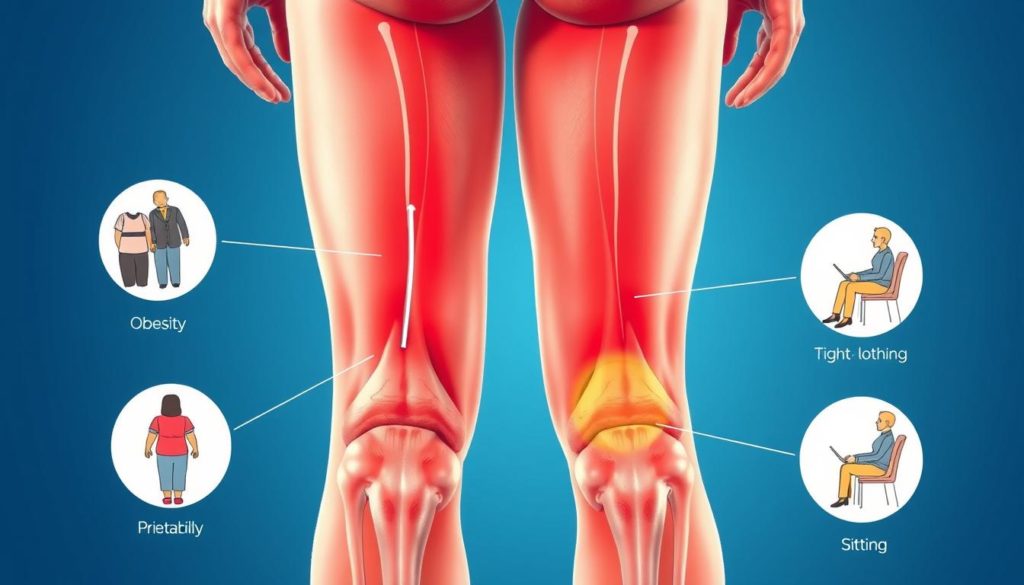About 32 in 100,000 people get Meralgia Paresthetica each year. This condition causes burning or numbness in the thigh. It happens when a certain nerve in the leg is squeezed.
Some people call it “thigh pain syndrome.” It can make you feel tingling, numbness, or pain in a specific area. But there’s hope. Many can find relief through simple steps or sometimes medical help.
We will explore what causes Meralgia Paresthetica and how to ease it. We’ll also share tips to prevent it. Knowing more about this nerve issue can help you deal with it better.
What is Meralgia Paresthetica?
Meralgia Paresthetica is also called lateral femoral cutaneous nerve syndrome. It’s a painful condition that affects the outer thigh. It happens when the lateral femoral cutaneous nerve gets compressed. This nerve gives feeling to the skin on your thigh. The reasons behind this condition include tight clothes, being overweight, or standing or walking for too long.
Definition and Overview
Meralgia Paresthetica causes numbness, tingling, and a burning pain in the thigh’s outer side. Known scientifically as lateral femoral cutaneous nerve syndrome, it starts from the compression of a specific nerve. This issue can cause severe discomfort and interfere with everyday life.
Common Symptoms
The main symptoms of meralgia paresthetica are:
- Burning pain over the outer thigh
- Tingling and numbness in the upper leg
- Increased sensitivity in the affected area
- Sometimes, an aching or deep pain in the groin

The symptoms can get a lot worse with activities that stress the nerve more. This highlights why it’s crucial to get it diagnosed and treated right.
Causes of Meralgia Paresthetica
It’s important to know why Meralgia paresthetica happens for proper diagnosis and treatment. It mainly occurs when the lateral femoral cutaneous nerve gets compressed. This can be due to various reasons or health problems.

Compression Factors
For Meralgia paresthetica, nerve compression is a key thigh pain cause. The inguinal ligament, which goes from the abdomen to the top of the thigh, can trap the nerve. Often, compression comes from:
- Tight clothing
- Increased abdominal pressure
- Scar tissue from past injuries or surgeries
Knowing these factors is a big step in diagnosing Meralgia paresthetica. It also helps identify changes in lifestyle that can ease the pain.
Medical Conditions and Diseases
Other than compression, certain health issues can also cause this nerve pain. Some of these conditions are:
- Diabetes
- Obesity
- Hypothyroidism
These problems can make the inguinal ligament more likely to trap the nerve. Getting a diagnosis for Meralgia paresthetica is crucial. It helps in treating thigh pain and can improve life quality.
Symptoms of Meralgia Paresthetica
Meralgia paresthetica (MP) causes feeling problems in the thigh. People often feel ongoing discomfort and other strange feelings. This can disrupt everyday life.
Burning Pain
MP is known for causing a burning pain in the thigh. This pain is severe and lasts a long time. It is usually felt on the thigh’s outer side.
The pain gets worse with a lot of standing or walking. It makes living with the condition hard.
Numbness and Tingling
MP often leads to numbness and tingling in the thigh. These feelings make the thigh seem odd, like it’s not part of the body. The numbness and tingling can spread, affecting how you move and your activity.
Increased Sensitivity
Increased sensitivity in the thigh is another sign of MP. Even a gentle touch can hurt a lot. This makes the burning pain worse. But, managing MP well can help cut down these symptoms and make life better.
Risk Factors Associated with Meralgia Paresthetica
Meralgia paresthetica is often caused by several risk factors. Knowing these can help people improve their health. It also helps lessen the effects of this condition.
Obesity and Weight Gain
Being overweight, especially around the belly, can cause thigh pain. This extra weight puts more pressure on a specific nerve. This pressure can make symptoms worse or even start the condition.
Pregnancy
Pregnant women face specific challenges. As the uterus grows, it can press on nerves. This pressure can bother the lateral femoral cutaneous nerve. This raises the chance of having this condition during pregnancy.
Diabetes
Diabetes is a major contributor to nerve damage. High blood sugar can lower blood flow to nerves, harming them. If this damage affects the lateral femoral cutaneous nerve, it can lead to meralgia paresthetica.
| Risk Factor | Impact |
|---|---|
| Obesity and Weight Gain | Increases pressure on the nerve and leads to weight-related thigh pain. |
| Pregnancy | Causes pregnancy-related nerve compression, irritating the nerve. |
| Diabetes | Results in diabetes and nerve damage impacting nerve function. |
Diagnosis of Meralgia Paresthetica
To start diagnosing meralgia paresthetica, doctors first look at your medical history. They seek common symptoms that hint at this condition. A deep neurological exam follows. This helps find the cause and rule out other health issues.
Clinical Examination
The first step in checking for meralgia paresthetica is a detailed nerve check. Doctors test for numbness and a burning feeling in your legs. They look into your health history too. This is to spot anything pressing on the nerve in your thigh.
Imaging and Electrophysiological Studies
Sometimes, more tests are needed beyond a physical exam. Tools like MRI or CT scans and nerve studies come into play. These tests can clear up if it’s really a nerve issue. They also show where the nerve is being squeezed.
Treatment Options for Meralgia Paresthetica
Treating meralgia paresthetica requires a well-rounded plan. Initially, the focus is on non-surgical ways. These ways aim to lessen nerve pressure and tackle the root causes.
Conservative Measures
Losing weight, wearing loose clothes, and avoiding certain actions help manage MP. Also, physical therapy with specific stretches can lessen nerve pressure.
Medications
Medications are key in treating this condition. Pain and inflammation can be reduced by over-the-counter NSAIDs. For nerve pain, doctors might suggest anticonvulsants or antidepressants.
When to Consider Surgery
If non-surgical methods don’t ease the symptoms, surgery could be an option for MP. Options like nerve decompression or cutting the nerve. These can significantly better the patient’s life.
| Treatment Options | Details | Effectiveness |
|---|---|---|
| Conservative Treatments | Weight loss, physical therapy, lifestyle adjustments | High in most cases |
| Medications | NSAIDs, anticonvulsants, antidepressants | Moderate to high |
| Surgical Intervention | Nerve decompression, nerve transection | High for severe cases |
Exercises for Meralgia Paresthetica
Targeted exercises are key in handling meralgia paresthetica symptoms. Stretching and strengthening moves reduce nerve pressure and ease thigh pain.
Stretching Techniques
Stretching boosts flexibility, easing the squeeze on the lateral femoral cutaneous nerve. Effective stretches are:
- Standing psoas muscle stretches
- Clamshell exercises
- Lunges
Regular practice can greatly cut down pain and boost how well you move. For top stretching tips, see this detailed guide.
Strengthening Exercises
Strengthening is just as vital. It makes the muscles around your pelvis and thigh stronger. This supports better and eases nerve pressure. Main exercises include:
- Core strengthening routines
- Thigh muscle conditioning exercises
- Aerobic activities
Adding these therapy exercises can give lasting thigh pain relief and better movement. Exercises aimed at nerve decompression especially help with meralgia paresthetica discomfort.
Seeking Professional Medical Advice
It’s key to know when to get medical help for Meralgia Paresthetica (MP). Getting help early can make your life better and stop worse problems. This is important for improving how you feel.
When to Consult a Doctor
If you feel ongoing pain, tingling, or numbness in your thigh, see a doctor. Seeing a doctor early for thigh pain helps find the best treatments. Be aware of these warning signs:
- Continuous burning or stinging pain
- Numbness or tingling sensations in your outer thigh
- Heightened sensitivity in the affected area
Start by talking to your primary care doctor. They will assess you and might send you to a specialist.
Types of Specialists
Several specialists may get involved with MP treatment:
- Neurologists: They deal with nerve issues and create detailed treatment plans.
- Orthopedic Physicians: They focus on bone and muscle problems and help with MP’s structural aspects.
- Physical Therapists: They offer exercises and rehab methods to lessen symptoms and improve movement.
Working together, these experts provide the best care. Getting help quickly and knowing when to get treated for MP is crucial. This approach is key to managing your symptoms and getting better.
Preventing Meralgia Paresthetica
Stopping thigh pain syndrome means taking many steps. We aim at lowering risks and starting positive habits for MP.
To keep nerves free, avoid tight clothes. Make sure belts aren’t too tight. Managing your weight is key because extra pounds can make symptoms worse. Staying active and eating well are essential.
For thigh pain prevention, move your body correctly, especially with the same moves daily. Workspaces and tools should help, not hurt. Physical therapy can make you more flexible and ease nerve pressure.
Taking early steps for MP can make life better for those at risk. Sometimes, using pads or supports helps in jobs that have you on your feet a lot.
- Wear loose-fitting, comfortable clothing.
- Maintain a healthy weight through a balanced diet and regular exercise.
- Engage in physical therapy to improve flexibility.
- Use ergonomic aids at work to minimize strain.
- Incorporate protective padding when necessary.
These steps help stop thigh pain and the chance of getting meralgia paresthetica. Changing your lifestyle, plus regular doctor visits, mean doing everything for MP prevention.
Lifestyle Modifications for Meralgia Paresthetica Relief
Making changes to your lifestyle can greatly help with Meralgia Paresthetica (MP) discomfort. Choosing comfortable clothing is a key step. Avoid tight clothes and belts since they can press on your nerves. Instead, wear loose-fitting clothes to lessen pressure on sensitive areas. This easy switch is a quick way to cut down on pain.
Another critical action is keeping a healthy weight. Too much weight puts extra pressure on your nerves, worsening MP symptoms. Eating a balanced diet filled with vitamins and minerals is important. It helps your nerves stay healthy. Also, staying active with regular workouts helps manage your weight and strengthens your muscles. This not only helps with your waistline but also supports nerve health and function.
Also, think about your daily environment and how you move. If you sit or stand a lot for work, make sure your space supports your posture. Adjust your desk and chair to fit your body right. And remember to take short breaks to walk and stretch. These small changes in how you work and live can make a big difference in easing thigh pain and boosting nerve health.
FAQ
What is Meralgia Paresthetica?
Meralgia Paresthetica (MP) is a condition that affects the outer thigh. It causes numbness, tingling, and a burning feeling. This happens when the nerve providing sensation there is squeezed.
What are the common symptoms of Meralgia Paresthetica?
People often feel burning, numbness, and a higher sensitivity in one thigh. Standing or walking can make these feelings stronger.
What causes Meralgia Paresthetica?
Tight clothing, extra belly pressure, or scar tissue can squeeze the nerve. Diseases like diabetes may also harm the nerve, leading to MP.
How is Meralgia Paresthetica diagnosed?
To diagnose MP, doctors examine patients and review their symptoms and medical history. They may also do tests on the thigh or use imaging studies to help with the diagnosis.
What are the risk factors for developing Meralgia Paresthetica?
Being overweight, gaining weight, and being pregnant can press on the nerve. Diabetes raises the risk too because it can damage nerves.
What treatment options are available for Meralgia Paresthetica?
Treatments include changing your lifestyle and taking medicines like NSAIDs to ease pain. Serious cases might need surgery to relieve the pressure on the nerve.
What exercises can help with Meralgia Paresthetica?
Stretching and strengthening exercises can ease the pressure on the nerve. These activities also help with flexibility and muscle strength, which can reduce symptoms.
When should I seek professional medical advice for Meralgia Paresthetica?
See a doctor if you have ongoing burning, numbness, and sensitivity that affect your daily life. Getting help early can lead to better results.
What lifestyle modifications can relieve Meralgia Paresthetica?
Wearing looser clothes, eating right to keep a healthy weight, and exercising regularly can manage symptoms. These steps also support nerve health.
How can I prevent Meralgia Paresthetica?
To prevent MP, avoid tight clothes, manage your weight, and take steps to lessen nerve squeezing. These changes can majorly cut down the risk.


